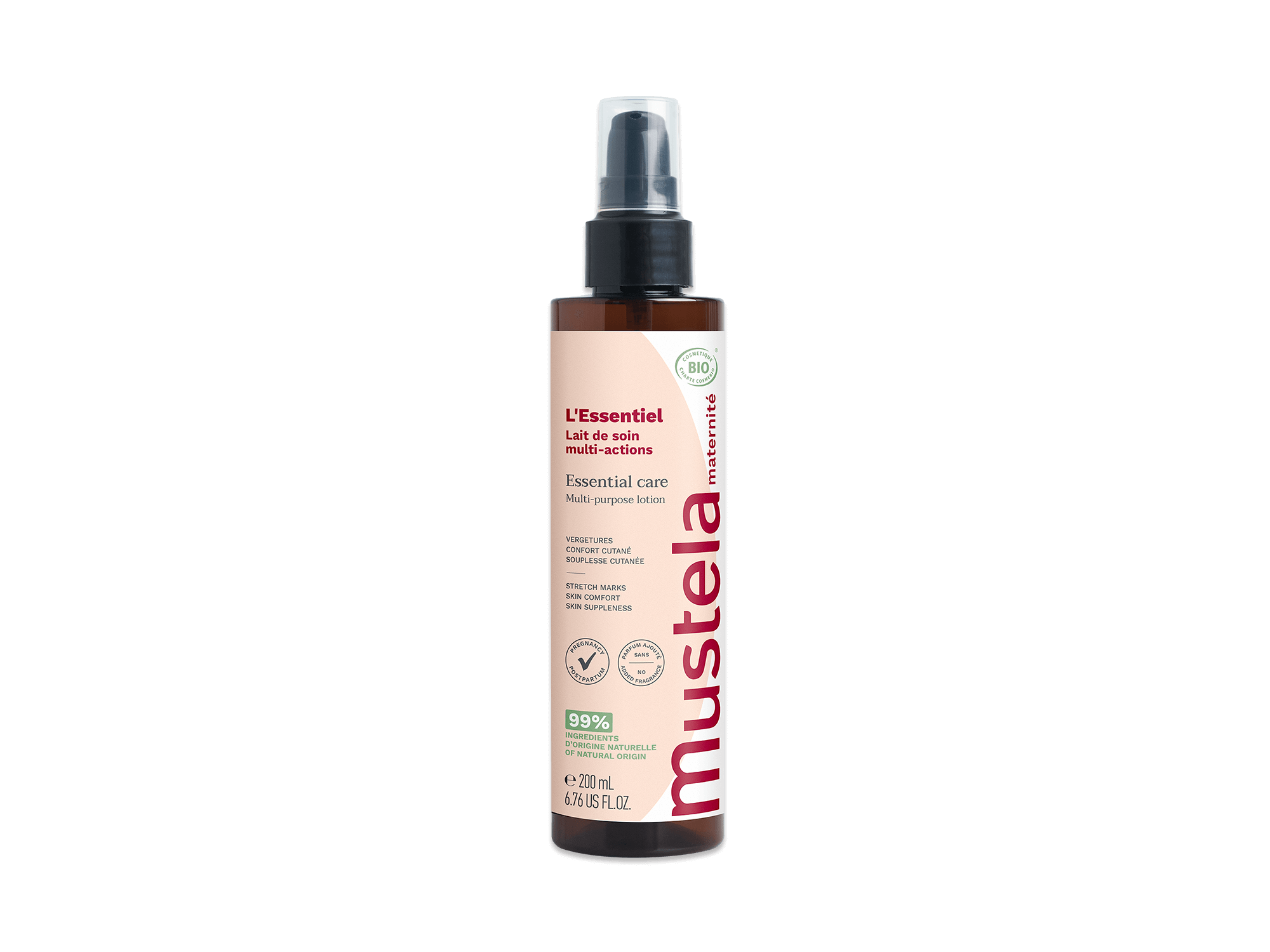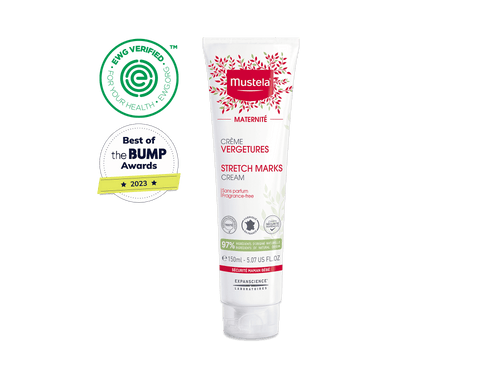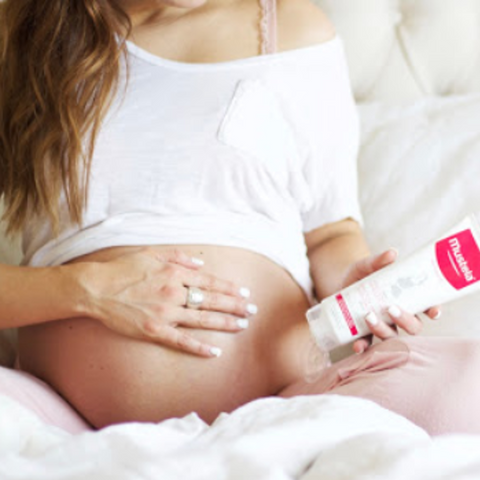Your body went through some pretty crazy changes during pregnancy, including changes in your breasts. Even though your little one is now in your arms, the challenges aren’t over yet. Many new mothers struggle with tender, sore nipples from breastfeeding.
While it’s normal to experience sensitive breasts and sore nipples when you start nursing, it’s not normal to have ongoing soreness or pain while breastfeeding. If the latter sounds like you and you’re ready to throw in the towel, don’t give up just yet!
In this article, the experts at Mustela explain some of the common causes of sore nipples and how to treat them. You and your little one might be back on the happy breastfeeding train faster than you think!
Table of Contents
What Causes Sore Nipples When Breastfeeding?

There are several reasons that nursing moms might deal with sore nipples. The good news is that once you figure out what’s causing your discomfort, it will be easier to remedy. Let’s jump right into some of the most common causes.
Baby’s Attachment Or Position
When they are ready to nurse, your baby’s mouth should be wide open as if they are about to yawn. And when they latch on, they should have a large mouthful of breast, covering all or most of the areola, with your nipple toward the back of their mouth.
Additionally, it works best if you bring the baby to the breast, not the breast to the baby.
The WIC Breastfeeding Support page offers the following signs of a good latch.
- It should be comfortable and pain-free with the baby’s chest and stomach resting against your body.
- Their lips should be turned out and form a seal around your nipple.
- Their chin will be against your breast and their tongue will be under it.
- You will be able to see them swallowing and may see their ears moving slightly.
If they aren’t attaching well or don’t have their mouth where it should be, the roof of their mouth or their tongue can rub against your nipple. The likely result? Nipple soreness.
Flat Or Inverted Nipples
Just like bodies and breasts, nipples come in various shapes and sizes — and they’re all beautiful! The only problem is that certain nipple shapes might make it hard for your baby to latch on well.
And, as we mentioned, if your infant doesn’t latch on correctly, you may end up with sore nipples.
Flat nipples, for example, won’t stick outward from the breast even when stimulated. And inverted nipples turn in, or retract, even when stimulated. Having flat or inverted nipples might not prevent you from breastfeeding entirely, but it could present challenges.
Tethered Oral Tissues (Tongue-Tie And Lip-Tie)

What exactly is a tongue-tie? There is a piece of tissue that stretches from the underside of your baby’s tongue to the floor of their mouth. When that tissue is unusually short, it’s called tongue-tie.
The Cleveland Clinic notes the following symptoms of a tongue-tie:
- Difficulty latching when breastfeeding
- Breastfeeding for extended periods
- Constant hunger
- Trouble gaining weight
- A clicking sound while your child is feeding
Similarly, lip-tie is a condition in which the tissue behind your baby’s upper lip is too tight or stiff. This keeps the upper lip from being able to move freely enough and can affect breastfeeding.
Some babies with such tethered oral tissue trouble are still able to breastfeed without problems. But these issues could cause your little one to have trouble latching on and nursing, which, in turn, can lead to nipple soreness for you.
Milk Blebs
Milk blebs, also called milk blisters, occur when a nipple pore gets blocked. They look like little white spots on the skin and can often be resolved at home. You can try gentle nipple massage, soaking your breasts in warm water and Epsom salts, or a warm compress.
You may even find that nursing itself can clear the issue.
However, if you do need your doctor’s help, they may use a sterile needle to unblock the pore. But be sure not to try the needle method on your own, as you may cause an infection.
Palate Abnormality
Another potential cause of breastfeeding difficulty (and sore nipples) is a palate abnormality. If your baby’s palate (the roof of their mouth) is abnormal, breastfeeding might be tricky.
Incorrect Breast Pump Use
Just like it’s important for your little one to latch on correctly, it’s also important to use your breast pump correctly! Your nipples can become irritated if the suction on your breast pump is too strong or if you use the wrong size breast shields.
Infection
There are several types of infections you can get on or around your nipples while breastfeeding. You’re especially at risk for infection if your nipples are damaged and cracked.
Two of the most common infections are Thrush (Candida albicans) and Staph (Staphylococcus aureus).
Thrush is a fungal yeast infection. And since it can infect your baby’s mouth as well as your nipples, it can be passed back and forth between mother and child. That means you and your baby should be treated at the same time.
Signs to look for include white spots on the tongue, gum, or lips of your little one that do not come off when wiped gently with a cloth.
Staph bacteria are commonly found on surfaces in our environment and even our skin. A staph infection occurs when bacteria enter a wound and can become serious if left untreated. These infections are also easy to pass from one person to another.
According to the CDC, although it is possible to pass the infection on to your infant, most of the time, moms with a staph infection (including MRSA) can continue to breastfeed. But open wounds and abscesses should be covered with a bandage so the baby isn’t exposed.
Vasospasm
Vasospasm occurs when the blood vessels in the nipple narrow, causing less blood to flow to the area. This condition is associated with a shallow latch and Raynaud’s Disease.
It may or may not happen during breastfeeding, but it typically happens afterward and may also happen when stepping outside on a cold day or when getting out of a warm shower.
You may be able to avoid the pain by dressing warmly, wearing wool breast pads under your clothes, and by putting on a towel or robe on right when getting out of the shower.
The nipple pain related to vasospasm is often described as a “pins and needles,” or burning, throbbing, or stabbing pain in the nipples after the baby unlatches from the breast. If your sore nipples are related to vasospasm, you’ll probably notice that they’re white after nursing.
Eczema
If your nipples are itching as well as being sore, it could be that you’re dealing with nipple eczema. This is usually caused by clothes, soaps, or products that irritate your skin.
Speaking of eczema, if it runs in your family and your little one has eczema as well, don’t worry. When it comes to dressing, bathing, and quick cleanups for your eczema-prone baby, we’ve got you covered.
Mustela offers specifically designed products for eczema-prone skin — like Stelatopia Intense Eczema Relief, Stelatopia Foam Shampoo, and our Eczema Bath Time Set to help soothe your little one’s skin and relieve discomfort.
Psoriasis
Psoriasis affects a small but significant percentage of breastfeeding moms. It is a genetic autoimmune disease that causes skin cells to multiply too quickly so that plaques form on the skin. These plaques are typically found on parts of the body not exposed to the sun.
It can be bad enough to have psoriasis on other parts of your body, but it is especially painful when it occurs on your breast or nipple while you are nursing.
The American Academy of Dermatology reports that light therapy, usually used to treat women with moderate to severe psoriasis, is often prescribed for nursing moms since it has never been known to harm a nursing baby.
Sometimes, a topical vitamin D ointment is prescribed to treat psoriasis, or your diet can be tweaked to include more of it. Dietary sources of vitamin D include foods like fatty fish, fish liver oils, mushrooms, and fortified foods.
Preventing And Treating Sore Nipples
Tips For Preventing Sore Nipples
Preventing sore nipples before they even strike is your best option! To do so, check that your baby is latching on correctly and follow these four tips.
1) Notice Your Baby’s Hunger Cues
Learn what your baby does when they start to get hungry — and don’t wait for the late signs of hunger, like crying.
When babies begin to get a rumbly tummy, they often suck on their fingers or open their mouths and move their heads side-to-side, which is called rooting.
Once your baby gets too hungry, you’ll probably have a more difficult time getting in the right position and helping them latch on correctly. To make things easier for both of you, nurse your baby before they get cranky.
2) Change Positions
Part of breastfeeding is learning what works for you and your little one, and that includes positioning. Experiment with breastfeeding positions to see which one makes it easier for your baby to latch on.
If you have a few positions that work well, consider switching things up at each feeding so that your baby’s mouth isn’t always in the same position on your nipple, which can contribute to sore nipples.

3) Keep Your Nipples Dry
Keeping your nipples dry between feedings is an important step in preventing soreness and irritation.
Ensuring that they don’t stay wet includes airing out when you can, letting your nipples air dry if you’ve applied breast milk, and changing your breast pads frequently.
4) Wear A Comfortable Bra
As obvious as it sounds, when your nipples are extra sensitive, you’ll want to treat them as gently as possible by wearing a comfortable bra. This might mean you need to do a little shopping or browsing on the internet.
For the least irritation, choose a bra that’s not too tight and make sure the fabric is soft.
5) Change Your Breast Pads Frequently
Wearing breast pads can be really helpful in keeping any leaks from showing through your clothes. This is especially true early on in your breastfeeding journey or anytime you are overly full.
But it’s important to change your breast pads every time you notice they are wet so bacteria don’t have a chance to grow. This might be as often as every feeding.
6) Hand Express To Soften The Breast
If you find that your breast is hard or swollen with milk, you can release some of the pressure by hand-expressing a little milk before the next feeding.
Softening the hard, pressured surface of the breast can keep the nipples from flattening out and causing your baby to struggle to latch on as well, which can chafe or irritate the nipple further.
7) Feed Your Baby More Often
It doesn’t help your nipples feel any less sore from breastfeeding if you feed less often. In fact, feeding less often can make things worse by causing engorgement.
Engorgement means your breasts are so full that it becomes harder for your baby to latch on properly, and poor latch leads directly to sore nipples. The La Leche League specialists advise that you breastfeed your baby frequently from birth: at least 8–12 times in 24 hours.
8) Help Your Baby Unlatch
The strong seal that forms with a good latch ensures that your baby is getting the nutrition they need. But sometimes, your little one will fall asleep or isn’t ready to let go by themselves.
If you find yourself in that situation, you may need to help them unlatch.
You definitely don’t want to pull the baby off your breast as that can damage your skin. To help them unlatch, gently place a clean finger inside your baby’s cheek and between the gums. Pressing lightly against your breast should break their latch.
Tips For Treating Sore Nipples
If you’re reading this article, you might already be dealing with the discomfort and pain of sore nipples. Follow the above tips for prevention in addition to these seven tips for treatment.
Take care of your sore nipples so you can get back to pain-free breastfeeding as soon as possible!
1) Talk To A Lactation Consultant Or Your Doctor
Breastfeeding shouldn’t be painful, so don’t be afraid to go to a professional for help and advice! If you’re experiencing major discomfort, check in with your doctor to make sure it’s nothing serious.
Your doctor can check to see if your baby has tongue-tie or lip-tie and, if they do, he or she can make recommendations on how to deal with it. Your doctor will also be the one to prescribe antibiotics or antifungal cream if you have an infection.
They may also recommend seeing a lactation consultant. A lactation consultant can help you find the right position and make sure your little one latches on correctly — both of which are important in preventing and treating sore nipples.
2) Get Help Early
As soon as you realize there’s a problem, you should get help. The longer you wait, the more potential there is for multiple problems.
For example, the more nipple tissue crack, the more openings there are for infection to take hold. Cracks can also create conditions that lead to mastitis.
3) Start On The Good Side
Even if breastfeeding with sore nipples is uncomfortable for you, try not to limit the time your baby spends nursing. Instead, start your baby on your least painful nipple. They won’t be quite as vigorous on the second breast.
4) Apply Breast Milk
Applying breast milk to sore nipples is effective and easy — it’s antibacterial and you’ve always got it on hand! To help soothe and heal sore nipples, apply a couple of drops of breast milk to your nipples after breastfeeding.
The exception to this advice is when your breasts hurt because you have thrush, in which case you should not apply infected breast milk to sore nipples.
5) Apply Nursing Comfort Balm
To prevent sore nipples or treat them once you’ve got them, apply Mustela Organic Nursing Comfort Balm after breastfeeding.
It’s made of 100% food-grade ingredients and contains nourishing olive oil, which is rich in Omega-6 and 9. Plus, it’s fragrance-free and dermatologist-tested.
Use our Nursing Comfort Balm with confidence, knowing that it’s eco-friendly, safe for both you and your baby, and will soothe and protect your breasts.
6) Apply Warm Compresses
Applying moist heat to your breasts and nipples for a couple of minutes right before you breastfeed might provide you with soothing relief, and it’s easy to do! Simply soak a washcloth in warm (not hot) water, wring out excess water, then lay it over your breast and nipple.
You could also take a warm shower, or soak your breasts in a basin of warm water. In addition, a heating pad against your chest can provide some relief, too. This can be especially helpful with milk let-down, or if you experience vasospasm or engorgement.
7) Use Ice
While heat is good for sore nipples from breastfeeding, ice can be useful as well. Try using a package of frozen peas covered with a thin cloth on your nipples or an ice cube directly against cracked or sore nipples. This can be a soothing solution right after nursing or between feedings.
Enjoy Breastfeeding Again
Breastfeeding can be a sweet, intimate moment between you and your little one. But it’s far from enjoyable if it causes you discomfort and pain when you have sore nipples from breastfeeding.
Take steps toward healthy nipples with these tips, and keep Organic Nursing Comfort Balm handy. In no time, you’ll say “goodbye” to sore nipples and “hello” to enjoyable, pain-free nursing!



















